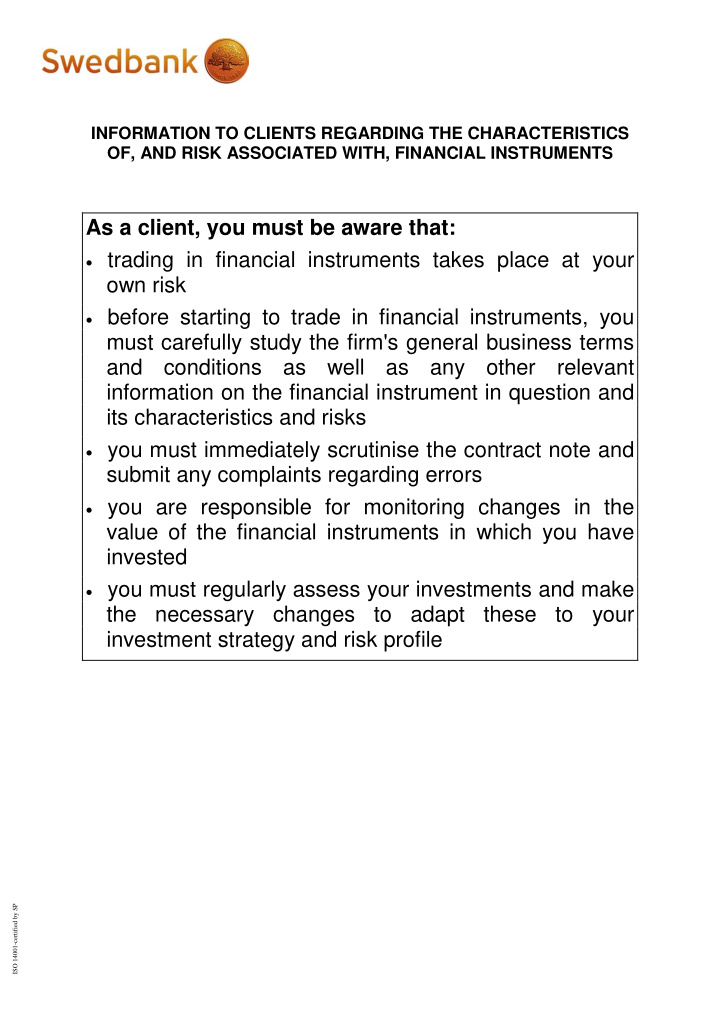



INFORMATION TO CLIENTS REGARDING THE CHARACTERISTICS OF, AND RISK ASSOCIATED WITH, FINANCIAL INSTRUMENTS As a client, you must be aware that: • trading in financial instruments takes place at your own risk • before starting to trade in financial instruments, you must carefully study the firm's general business terms and conditions as well as any other relevant information on the financial instrument in question and its characteristics and risks • you must immediately scrutinise the contract note and submit any complaints regarding errors • you are responsible for monitoring changes in the value of the financial instruments in which you have invested • you must regularly assess your investments and make the necessary changes to adapt these to your investment strategy and risk profile ISO 14001-certified by SP
2 (19) Contents 1. DEFINITIONS .................................................................................................................3 2. TRADING IN FINANCIAL INSTRUMENTS......................................................................4 2.1. Share trading ...............................................................................................................5 2.2. Share-like instruments .................................................................................................7 2.3. Interest-bearing financial instruments ..........................................................................7 2.4. Derivative instruments .................................................................................................8 3. RISKS RELATING TO TRADING IN FINANCIAL INSTRUMENTS..................................9 3.1. In general regarding risk ..............................................................................................9 3.2. Shares and share-related instruments ....................................................................... 10 3.3. Interest-bearing instruments ...................................................................................... 11 3.4. In general regarding the risk related to trading in derivative instruments .................... 11 3.5. The risk involved in various types of derivative instruments ....................................... 12 3.5.1. Options................................................................................................................... 12 3.5.2. Call options ............................................................................................................ 12 3.5.3. Put options ............................................................................................................. 13 3.5.4. Forward/futures contracts ....................................................................................... 13 3.5.5. Contracts For Difference (CFD) .............................................................................. 14 3.5.6. Swap contract ........................................................................................................ 15 3.6. Standardised and non-standardised derivative instruments ....................................... 15 3.7. Clearing ..................................................................................................................... 15 4. MUTUAL FUNDS .......................................................................................................... 15 5. EXCHANGE TRADED FUNDS AND FUND-LIKE PRODUCTS ..................................... 16 6. SHORT TRADING ......................................................................................................... 17 7. TRADING FREQUENCY AND COSTS ......................................................................... 17 8. LEVERAGED (DEBT-FINANCED) TRADING ............................................................... 18
3 (19) 1. DEFINITIONS Financial instruments. This is a generic term for the assets and liabilities that are traded in the securities market, derivative market and in part currency market and is further defined in section 2-2 of the Norwegian Securities Trading Act. Regulated market. A regulated market is a market for the sale of financial instruments. A regulated market has a licence and is subject to a number of rules and obligations. There is a separate Norwegian Act relating to regulated markets (the Stock Exchange Act). Stock exchange. A stock exchange is a regulated market that has a special licence to operate as a stock exchange and is entitled to use the term "stock exchange" in or in addition to its name. Multilateral Trading Facility (MTF). An MTF is not a regulated market; it is a trading venue for automatic matching of orders in financial instruments. All investment firms that meet the objective requirements set by the MTF may be member of the MTF and take part in its trading. In Norway, operating an MTF requires a licence pursuant to the Securities Trading Act. Systematic Internaliser (SI) . An investment firm that carries out extensive own-account trading in shares with clients must register as an SI for the financial instrument in question. An SI is obliged to offer binding bid and ask prices and to notify its clients of these. Dark pool. A marketplace where participants can submit orders that are not shown in an open order book. The orders will be automatically matched if another participant submits a corresponding order. There is often a requirement that such orders must be a minimum size and that matching must automatically take place at the mid-price, i.e. the average of the best bid and ask prices in the open order book. Some dark pools also allow investors to submit their orders to the pool themselves. Underlying assets/underlying financial instrument(s) . These are the assets or financial instruments that a derivative contract gives the parties the rights and obligations to buy or sell or that the parties have agreed to base a monetary settlement on. Option. A contract that gives one party (the Holder) for a limited period a right but no obligation to buy (a Call Option) or sell (a Put Option) an agreed volume of financial instruments at a predetermined price from/to the other party (the Writer). Forward/futures contract . A contract according to which both the buyer and seller agree that an agreed volume of financial instruments will be transferred from the seller to the buyer at an agreed price on an agreed date that is further into the future than the normal settlement period for the underlying financial instrument covered by the contract. Price swap . A contract linked to an agreed volume of financial instruments, a settlement price (the swap price) and a settlement date, and according to which the underlying financial instruments are not to be delivered but there is instead to be a monetary settlement based on the difference between the swap price and the market price on the expiration date. Contract for difference (CFD) . A contract according to which both the buyer and seller are bound to agree to a monetary settlement of the price developments of an agreed volume of one or a group of financial instruments, indices, currencies or similar. The buyer of a CFD makes a gain if the price rises and a loss if the price falls. A CFD does not have a predetermined expiration date but the buyer may close the position at any time. Credit Default Swap (CDS) . A contract which provides a buyer with an insurance against the issuer of a debt obligation being unable to settle the debt, in whole or in part, on the settlement date. Index option/index futures contract . A contract where the underlying asset is an index value, not a security. Such a contract is not settled t by delivering financial instruments but by calculating the contract’s monetary value. Short sale . The sale of financial instruments that a party does not own, but has borrowed to carry out settlement on time. The financial instruments are bought at a later date and handed back to the
Recommend
More recommend